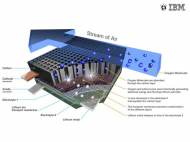Battery 500 Project – IBM’s lithium-air battery development
 IBM Research started the Battery 500 Project to develop lithium-air battery technology that could be used to power a family-sized electric car for approximately 500 miles (800 km) on a single charge back in 2009. The project has recently got additional support from Asahi Kasei and Central Glass – two companies with decades of experience in materials innovation – who will perform simultaneous investigation of several chemistries to increase the chance of success.
IBM Research started the Battery 500 Project to develop lithium-air battery technology that could be used to power a family-sized electric car for approximately 500 miles (800 km) on a single charge back in 2009. The project has recently got additional support from Asahi Kasei and Central Glass – two companies with decades of experience in materials innovation – who will perform simultaneous investigation of several chemistries to increase the chance of success.
“These new partners share our vision of electric cars being critical components of building a cleaner, better world, which is far less dependent on oil”, said Dr. Winfried Wilcke, IBM’s Principle Investigator who initiated the Battery 500 Project. “Their compatible experience, knowledge and commitment to bold innovation in electric vehicle battery technology can help us transfer this research from the lab onto the road.”
Although there are many efforts to introduce the usage of electric cars, the price and usability in everyday use hinder its adoption. Aside power generation technologies needed to support the eventual shift to electric vehicles, there are other hurdles such as affordability, weight, size, capacity and time needed to recharge the batteries.
Unlike currently used lithium-ion, lithium-air (Li-air) batteries have higher energy density due to their lighter cathodes and their primary “fuel” is the oxygen. In theory, the Li-air battery can store up to 1,000 times more energy than today’s lithium ion battery.
During discharge (driving), oxygen from the air reacts with lithium ions, forming lithium peroxide on a carbon matrix. Upon recharge, the oxygen is given back to the atmosphere and the lithium goes back onto the anode. Although IBM researchers managed to successfully demonstrate the fundamental chemistry of the charge-and-recharge process for Li-air batteries, they also found out that the chemical instabilities limit the lifespan of Li-air batteries during frequent recharges.
Central Glass, a leading global electrolyte manufacturer for lithium-ion batteries, will help with their chemical expertise in this field to create a new class of electrolytes and high-performance additives specifically designed to improve lithium-air batteries.
“New materials development is vitally important to ensuring the viability of lithium-air battery technology”, said Tatsuya Mori, Director, Executive Managing Officer at Central Glass. “As a long-standing partner of IBM and leader in developing high-performance electrolytes for batteries, we’re excited to share each other’s chemical and scientific expertise in a field as exciting as electric vehicles.”
Asahi Kasei, one of Japan’s leading chemical manufactures and a leading global supplier of separator membrane for lithium-ion batteries, will focus on development of a membrane technology for lithium-air batteries. Since membrane’s role is related to safe ion transportation, its development could allow better efficiency and stability of li-air batteries.
“We are very focused on addressing environmental challenges and limitations with diverse technology to build a brighter future. This alliance allows us to explore a new path to developing an improved rechargeable battery performance that can not be met with conventional technologies”, said Tetsuro Ohta, Head of Advanced Battery Materials Development Center, Asahi Kasei.
As you can see in the 2nd video, they compared the weight of Li-air batteries with Lead Acid and Li-ion batteries with roughly the same energy capacity of 500 Watt-hours. Although there’s noticeable progress made in weight reduction from 15.9 to 2.2 kilograms (35 to 4.85 lbs) when it comes to difference between Lead Acid and Li-ion batteries, the Li-air batteries weight only 0.3 kg (0.66 lbs).
Despite the facts that these batteries are lighter and have greater energy density, there’s still the need to make them more stable for everyday use, as well as improvement of manufacturing process that could lead to faster and less expensive production of these batteries. A working lab demo of the technology is expected by the end of 2013, and IBM researchers envision that these batteries will be commercially available sometime in the 2020s. It remains remains to be seen if some other technology beats it before then, or it could be used alongside it in a hybrid combination.









Why don’t more research groups focus to solve the problem and introduce these batteries earlier?
Although I like the technology and the idea, I don’t think it will get far.
I have a technology that makes batteries last decades longer. Maybe it would make this air battery a viable technology. Make me an offer…